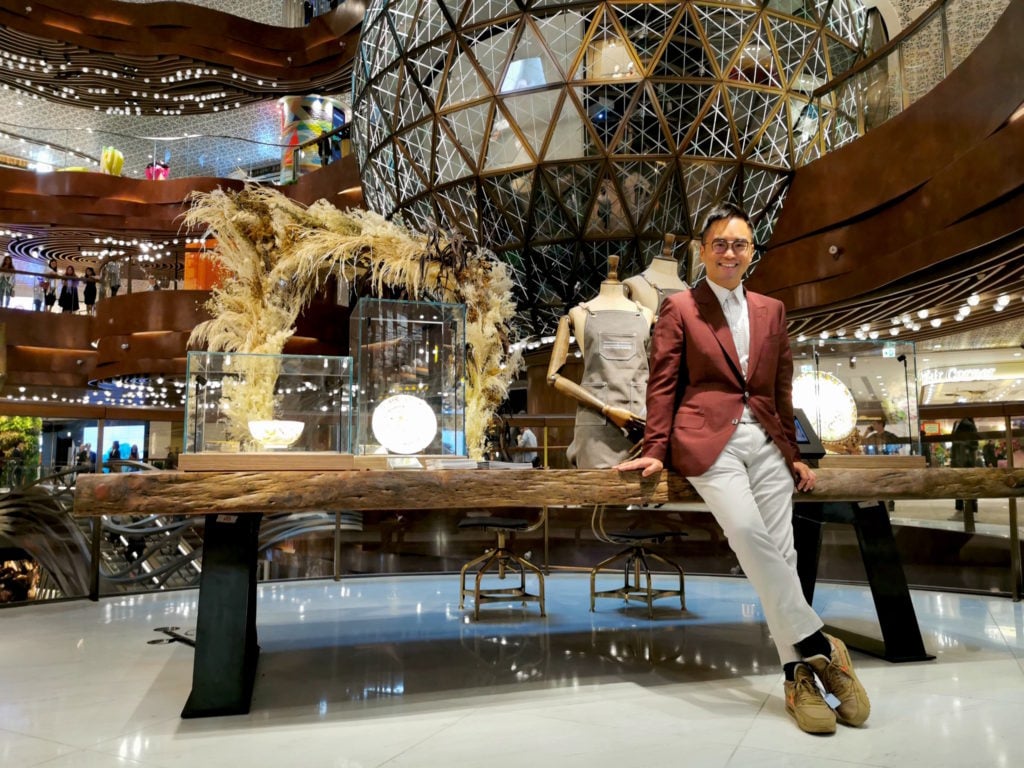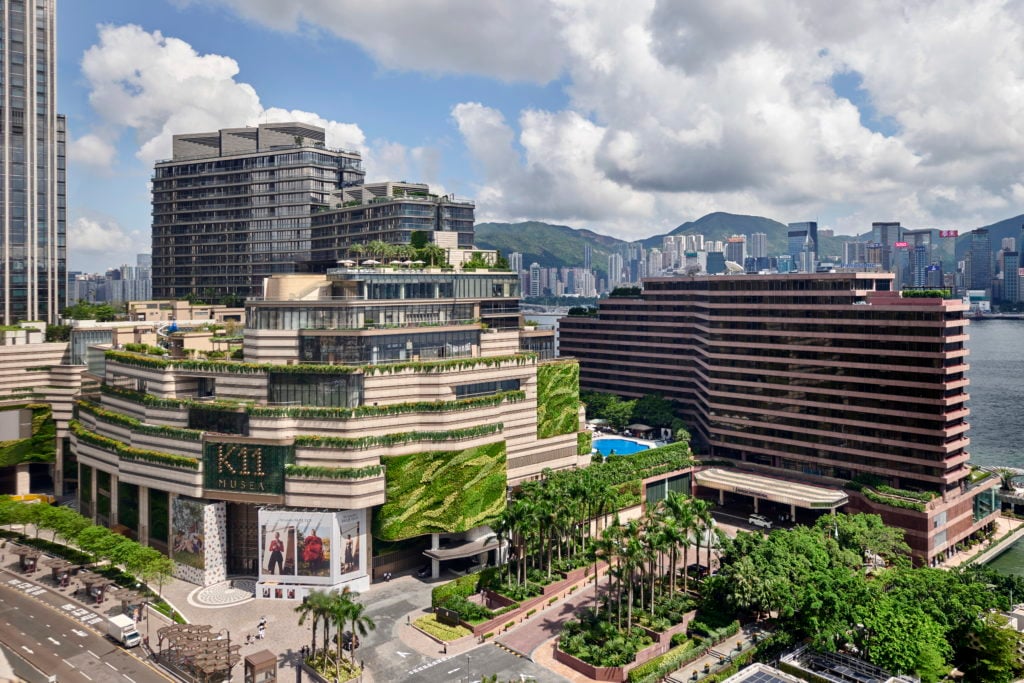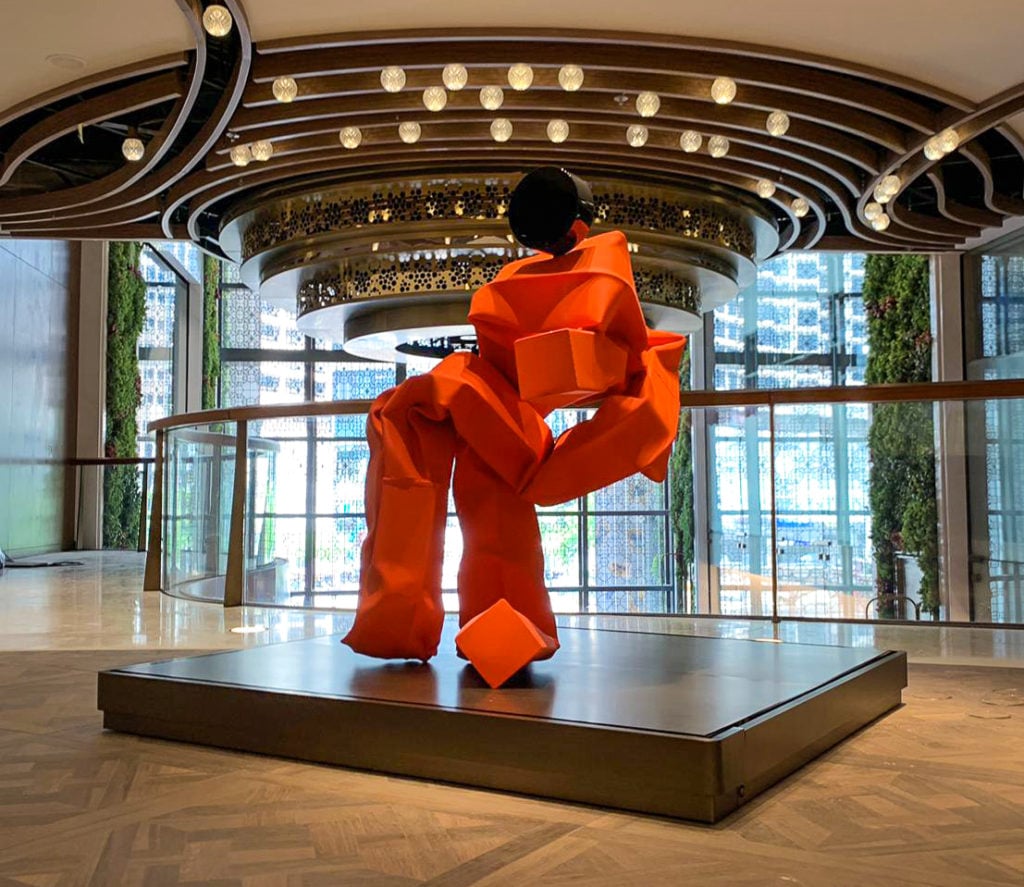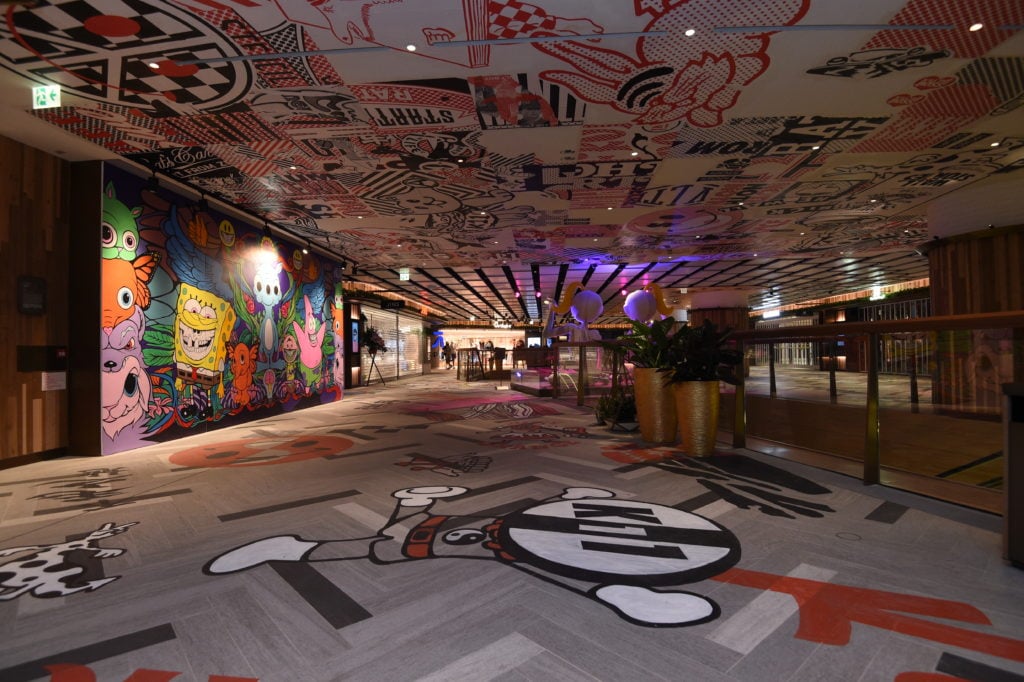People
K11 Musea Is the Culmination of Billionaire Collector Adrian Cheng’s Vision for a Hybrid Art-and-Luxury Empire. But He’s Not Done Yet
We spoke to K11 Musea founder about his sweeping plans for a new kind of culture-meets-commerce hub.

We spoke to K11 Musea founder about his sweeping plans for a new kind of culture-meets-commerce hub.

Vivienne Chow

On a sunny recent September afternoon, a well-dressed crowd could be found eating hot dogs and sipping champagne in an outdoor plaza to fête the unveiling of Erwin Wurm’s Hot Dog Bus in Hong Kong’s Tsim Sha Tsui shopping district. But there was more to the Asian launch of the Austrian artist’s famed sculpture-turned-food kiosk—which challenges people’s views of food and consumer culture—than a simple public-art debut. The presence of the supersize yellow sculpture heralded the opening of K11 Musea, the new, state-of-the-art museum/mall hybrid situated behind it.
It so happens that the low-key celebration also served as a stark contrast to the images of Hong Kong that have been circulating the world since the ongoing pro-democracy protests first gripped the city in June. Millions of people have been taking to the streets; some have been tear gassed, shot with sponge rounds, and even live bullets by the police. Violent counter-protests by members of the pro-government camp have been documented, together with protesters’ vandalism of pro-China shops, surveillance cameras, and subway stations.

K11 Musea in Hong Kong’s Victoria Dockside district. Credit: ©Francis Chen, Vacuum Workshop and courtesy of Ronald Lu & Partners.
And while the business world has been asking if Hong Kong is still safe as a mercantile hub, and the art world has been wondering if Art Basel will be able to pull of its fair in the city in March, the unveiling of Hot Dog Bus—and the K11 Musea “cultural-retail destination”—provided an answer of sorts: amid all the disruptions, it’s business as usual. More reassuring still is that this answer comes from none other than the city’s young art-collecting tycoon Adrian Cheng, founder of the K11 Group.
“The incubation of art, design, and creativity is very much needed at all times, and K11 Musea is a place that celebrates creativity,” Cheng told artnet News. “We have a social mission, and that is to serve the community. People come here to be inspired and to learn.” He noted that the new destination was already generating “good word of mouth” and drawing visitors. “I’m very blessed and grateful.”
The scion of one of the region’s biggest property developers, Cheng has come a long way since he opened his first K11 art mall in Hong Kong in 2008—brilliantly anticipating the way art and fashion would increasingly meld as global status symbols—and now, the inauguration of K11 Musea is another important milestone. That’s because the complex is really the crystallization of his decade-long efforts to forge a continuum between the ennobling experience of art, which he supports through his very active K11 Art Foundation, and the commercial goldmine of destination luxury retail. K11 Musea’s website presents it as the “Silicon Valley of culture,” “an incubator of art and the artisanal” inspired by “a muse by the sea.”
“K11 Musea is not just about art—it’s also about architecture, design, gastronomy, furniture, and a conversation among these elements to integrate culture into part of living,” Cheng said. “It’s natural that we have evolved and expanded our vision and focus from art to culture as a whole. It’s a growth journey that we are walking together.”
Since the founding of the original K11, Cheng—who will turn 40 this November—ventured across China to establish new locations in Shanghai, Guangzhou, Wuhan, and Shenyang. To plot out his return to Hong Kong with K11 Musea, he teamed up with Kohn Pedersen Fox, the architectural firm behind both New York’s Hudson Yards and Tokyo’s Roppongi Hills, and landscape architect James Corner Field Operations, which helped transform the High Line in New York into an elevated park. The project also pulled in Rem Koolhaas’s OMA and the Hong Kong-based architecture studio LAAB to conceive the shell of K11 Musea, a futuristic ziggurat of glass, steel, verdant plant life, and giant video screens.
Retail tenants at the 10-story K11 Musea are made up of a diverse mix of luxury purveyors, ranging from traditional high-end European fashion maisons to hip young brands that are less common in other malls, as well as a broad spectrum of more than 70 restaurants. It additionally houses L’Ecole, the first permanent site for Van Cleef & Arpels’s school of jewelry arts in the Asia-Pacific region.

Carol Bove’s Melty Legs (2018) in K11 Musea. Courtesy of K11 Musea.
As one might expect from the K11 chain, these stores are nestled in a dense context of cultural offerings—only to a degree that goes beyond previous iterations. First, there is the presence of the K11 Musea art collection, with works by 40 contemporary artists including Wurm, Elmgreen & Dragset, Katharina Grosse, Zhang Enli, Adrian Wong, Samson Young, and Haegue Yang displayed in attention-grabbing sites throughout the building.
Tours are offered of the collection, as well as of the architecture, design, and the collection of Danish Modernist furniture on display. There is also a satellite branch of the MoMA Design Store, which is already proving a draw.
Beyond art and design, music, dance, and theater performances are held regularly (sometimes for free, sometimes not). In November, cinema buffs can come to a Cannes Film Festival-branded week of movie screenings. For more culinarily inclined visitors, K11 Musea even offers a three-hour cooking class taught by a chef instructor from Le Cordon Bleu.
“These tours and programs are a good way to help people understand the vision,” Cheng explained. “We also have a cultural academy, offering short courses. This is a place where people can actually learn, not just discover.”
Cheng said customers today are hungry for venues that provide value beyond ephemeral experiences. “To learn, to gain knowledge capital, is what they desire the most,” he said. “People are willing to spend money on one-of-a-kind items, but you have to evolve with customers to build a community through space and content. You talk to one each other, sharing things the other person didn’t know—this is a basic human interaction. But this has yet to happen between a space and people, and K11 tries to do that.”
K11 has been an educational process for Cheng, as well. When he created the first iteration, people were intensely skeptical of an art-and-commerce venture. “People criticized me, saying that the art was not good enough, questioning if I was profiting from art-market speculation, or using art to increase the value of the property,” he said.
With the art in particular, critics said you can’t be taken seriously for just putting artworks in a mall—you needed to have curatorial oversight. “It’s important to take note of what other people say, so that you can become better,” Cheng said. “I started the K11 Art Foundation in 2010—sincerely, authentically—to promote art and build an art village [in Wuhan], partnering with museums, running artist residency programs. Then we had great content to propagate art while developing a new model.” K11 Art Foundation is now led by the highly regarded curator Venus Lau.

Katol@startfromzero’s Chaotic Order (2019) in the K11 Musea. Courtesy of K11 Musea.
Today, K11 also owns a separate collection of more than 300 artworks by famous artists like Yoshitomo Nara, Olafur Eliasson, and Yinka Shonibare. But Cheng’s evolving outlook also inspired him to set up a Crafts and Guild Foundation under the K11 brand to preserve fast-disappearing traditional Chinese handicrafts, such as guangcai—Chinese porcelain painting—and filigree inlay art.
“Ten years ago, I definitely was not interested in that, or Scandinavian furniture,” he said. “But art grows with age, and it’s not just about their aesthetic beauty but also the history. Do you know last year there were 130 of these [guangcai] artisans in Beijing, and this year there are only 30? Some passed away, and some stopped simply because there’s no work.”
Because of the foundation’s support, these artisans suddenly have a lifeline of sorts. “Now some of them need to hire more people,” Cheng said. “In this way, their skills and experiences can be handed over to the younger generation.”
K11 Musea is the centerpiece of Victoria Dockside, the 3 million-square-foot site located on the promenade of Tsim Sha Tsui’s waterfront. Formerly known as Holt’s Wharf, the site was a logistics hub serving as a gateway to the Far East dating back to 1910. Cheng’s grandfather, Cheng Yu-tung, acquired the land in the 1970s and developed it into the New World Center, an iconic commerce-retail-hotel complex symbolizing the economic prosperity of the city and its lively pop culture. It was once home to the then-trendy Hong Kong branch of the Tokyu Department Store and the city’s biggest Chinese restaurant-nightclub, which became the cradle of Canto-pop music.
Today, K11’s parent company, New World Development—for which Cheng serves as executive vice chairman and general manager—has developed this area into the $2.6 billion Victoria Dockside, an art and design district with a mix of retail, office spaces, the luxury Rosewood Hotel, and private residences. The site also features other pricy outgrowths of the K11 brand: the K11 Artus, a full-service “artisanal home” apartment block adjacent K11 Musea, and the K11 Atelier office tower.
Victoria Dockside is also near the Hong Kong Museum of Art, which will reopen at the end of November after a major facelift, as well as the popular Hong Kong Space Museum and the Hong Kong Cultural Centre, a key venue for the performing arts. This means the Tsim Sha Tsui waterfront stands to soon become an arts nexus to rival the West Kowloon Cultural District on the other side of the Kowloon peninsula, which has yet to fully open. (The M+ art museum, the anchor of the West Kowloon Cultural District, is scheduled to debut in late 2020 or early 2021.)

Cheng Ran’s Always I Trust, 2014, in K11 Musea. Courtesy of K11 Musea.
The end of the road to K11 Musea marks a new beginning. Looking out at the spectacular harbor view from the floor-to-ceiling windows of Commune, K11 Artus’s brand-new restaurant, Cheng is already cooking up plans for what to do next. The heir to a $17.2 billion family fortune is planning a sustainable new property project in Shenzhen and a cultural and heritage conservation initiative in Beijing. These projects will form the bulk of Cheng’s next five-year plan.
“Shenzhen is a highly commercialized place, but there is not enough cultural content,” he said, adding that “in mainland China, sustainability is built into technology, but it’s still very new as a facet of living culture.” With his new project, he said, “the property is located by the sea, so there is an opportunity to experiment with the concept of sustainability,”
Looking back, Cheng said that, in all of his endeavors, he has mainly been trying to disrupt the old way of thinking. Besides his family’s engagement with art, the New World Development empire donated 3 million square feet of its farmland reserves for social housing in September. The move sparked some chatter, since it emerged just two weeks after Beijing accused Hong Kong developers of not helping alleviate the city’s housing problems, a source of widespread discontent among younger people that some say has added fuel to the raging protests.
But Cheng dismissed the political interpretation, saying that the developer had been working with the NGO responsible for building social housing since the beginning of last year, and that the latest donation was just a top-up of a previous donation.
“I think a lot of the old way of thinking is about protecting the land, not giving anything away,” he said. “But giving away land is a way to show that you care about the stakeholders in the society, not just shareholders. Yes, shareholders are important, but you also want to be sharing social values, you want to do good for the society.”
Criticism, it seems, is an unavoidable side effect of Cheng’s ambitious vision. “People always have a lot to speculate,” he said. “But I’m very simple. I just want to create a new way of thinking.”